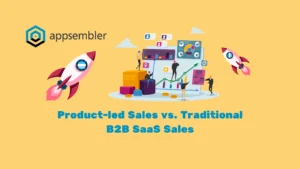With this guide on increasing product adoption, you will learn what strategies, best practices, and tools you’re currently missing out on that could make a big difference.
Whether you’re in startup mode or an established business, one of the most difficult parts of nurturing business growth is encouraging product adoption among new prospective buyers. It can be overwhelming to determine how to educate them on your product’s merits, answer questions about their particular use cases, and maintain frequent touchpoints to close the deal. As a result, many organizations ultimately drop the ball and lose out on potential new customers and increase sales with existing customers.
Here’s what you need to do to increase product adoption:
- Implement an LMS platform to train employees to sell your product better.
- Use an LMS platform to teach current customers and prospective buyers about your products.
- Analyze how your competitors bring in new clients and pay attention to bigger trends in your industry.
- Make customer-first decisions about how to sell and onboard.
Table of Contents
What is Product Adoption?
Product adoption is what ultimately happens when a prospective buyer becomes aware that your product exists, begins to use it regularly, and officially adopts it as part of their personal portfolio of products, services, or subscriptions. Product adoption is important in building the buyer-seller relationship in both B2B and B2C contexts.
While it is ultimately the customer’s decision whether or not they want to adopt a product, the vendor typically runs ads, gives sales pitches, and makes other strategic moves that help to grow product adoption rates and buyers’ awareness of and satisfaction with the brand.
How to Increase Product Adoption
Increasing product adoption is just as much about reaching customers where they are in their buyers’ journey as it is about crafting a solid product. Reaching customers requires that vendors know their customers well and invest the time, research, and budget necessary to reach them on their preferred buyer channels and terms.
To improve your chances of increasing product adoption rates across current customers and potential buyers, consider incorporating the following tips into your sales strategy:
1. Use an LMS to Manage Customer Education

A learning management system (LMS) is a software platform that allows administrators to assign and monitor learners’ courses on various topics. It also enables learners to guide their own educational journeys with self-service course modules and gamification features. LMS platforms are frequently used for internal educational initiatives in both schools and businesses, but they work just as effectively for customer education if your team takes the time to create a strategic learning plan and select the right LMS platform.
Your best bet is to use an LMS platform that combines traditional online courses with virtual training labs for a more well-rounded experience. While the traditional LMS component includes learning modules that handle qualitative knowledge-building and answer many common questions about a product or service, the virtual IT labs component gives users hands-on opportunities to learn how the product or software works and how it might fit their particular use case.
Giving customers the chance to learn about your product from both angles through an integrated learning platform gives them the confidence they need to commit to your product more quickly and enthusiastically.
2. Improve Onboarding
Even if you’ve produced an excellent product, you’re only likely to reach high user engagement and retention rates if your onboarding process is fine-tuned to address user questions from the outset.
That means not focusing all of your customer experience efforts on the sales, demo, and free trial periods of the buyer lifecycle, though these steps remain important. Instead, dedicate resources and members of your team to providing implementation, customer success, and other forms of customer support for new customers during their first 30, 60, and/or 90 days of product usage.
If you have a highly technical product or service, ensure a technical onboarding lead is available to walk prospective customers through demos and the more complex features and functions of your product during these early days. Giving users access to expert resources will help them — and your ticketing system — avoid unnecessary customer support headaches down the road. It will also make them more likely to recommend your product to other prospects because of the support they’ve received.
3. Usability: Create a Clear Path to Value
A clear path to value should be illustrated from the start of the sales cycle, and these efforts shouldn’t stop after a customer has committed to your product. In fact, your efforts to showcase your product’s usability and utility across different use cases should actually ramp up after a customer has selected your product if you want to retain their loyalties.
Taking the time to problem-solve a customer’s existing pain points and consider how your tool may address other underlying issues in their business or industry is an important step toward moving beyond one-off product usage toward true product adoption and a more multifaceted working relationship with this client.
However, it’s important to remember that not all customers or prospects will be receptive to this sales-y type of talk. That’s why it’s important to give them real-world examples and scenarios of how your product has solved a similar problem to what they’re facing. Whenever possible, share relevant customer stories, case studies, white papers, and other concrete evidence of what you can offer to help them further.
4. Incentivize Product Adoption
Sometimes, additional sales tactics are necessary to incentivize buyers to adopt your product. When that’s the case, get creative and consider which incentives and rewards will mean the most to your target audience.
For example, if your product primarily targets students or career-driven people who are hoping to increase their on-the-job skills, consider using an LMS with gamification features so you can offer them rewards like badges and leaderboards or perks like certifications and nano-degree programs.
If you’re selling consumer products in a retail or hospitality type of setting, consider setting up a loyalty rewards or discount program for your most loyal customers. Managing these kinds of incentive programs can feel like a lot of work if you’re not used to them, but thankfully, a number of gamification and customer experience applications are now available out-of-the-box or can be customized by vendors who want to create white-labeled customer rewards applications.
5. Conduct Market Research to Decide Improvements
Market research is perhaps the most important and complex step vendors can take to increase product adoption across their customer base actively. Any given market will have its own quirks and customer expectations, but in general, these diverse types of market research will help you create a better product, value, proposition, and customer experience moving forward:
- Customer analytics: Monitor activity and conversations in user communities, online forums, review sites, chatbot conversations, and other places where customers talk about their experiences. Data analytics and AI-driven analytics tools are particularly helpful for keeping track of large datasets that include these kinds of qualitative responses and brand sentiments.
- Customer surveys: Survey current users and prospects on what they like about current products, what’s missing, and what they hope to see in the future; conduct these surveys through multiple channels, including email, social media, and online chats.
- Research UX/UI design: Consider how well your website and any other digital elements of your product are working. Should your advertising, product features, or aspects of your web design be updated to reach your target audience better?
- Buyer persona research: Consider your current customers and determine how well their demographics and buying patterns align with your ideal customer persona. Through these combined data points, figure out who you should target for future product adoption opportunities and how to reach them.
- Industry and global trends: Pay attention to trends in your industry and beyond that could help you promote or enhance your product. For example, AI and generative AI could be used to improve your product’s speed or usability.
- Competitor analysis: Research what your direct competitors are doing to increase product adoption. What do their existing customers like about their product and value proposition?
Using Appsembler to Increase Product Adoption
Appsembler is the best e-learning solution and LMS platform for product and customer education that ultimately gives vendors a focused and easy-to-monitor channel for increasing product adoption. With Appsembler, vendors have the following features and benefits that can help them in this area of customer relationship management:
- An integrated LMS and virtual IT lab setup for better hands-on learning experiences.
- Site and page builders.
- Course authoring tools.
- Guided onboarding and learning resources.
- Advanced administrative analytics and reporting features.
- Learner certificates, badges, and gamification components.
- Custom domain and CMS integration.
- Lead and MQL generation features for marketers.
- Developer-specific marketing tools.
Appsembler: Streamline and Drive Product Adoption
Customer training is a huge component of driving product adoption, and LMS solutions make it possible to target and organize your efforts in this area. With Appsembler, vendor-users ultimately benefit from a solution that balances user-friendliness on both the customer and user side with robust analytics, customization, and integration capabilities for better results.
Interested in trying out Appsembler for your customer education, onboarding, and retention needs? Book a demo with our team today.
Frequently Asked Questions
When trying to boost product adoption, there are 5 common obstacles:
1. User Awareness (or lack thereof): Users are not aware of a product’s existence and/or the benefits it provides.
2. Unclear Value Proposition: If the product’s value and benefits are not explicitly communicated, with clear applications, users tend to be more hesitant to adopt it.
3. Usability: Insufficient training and customer support can hinder adoption as people are less likely to engage with a solution or process they don’t understand.
4. Resistance to Change: People like the familiar. Sometimes, it is as simple as that.
5. Competition with Existing Solutions: Competing against established alternatives can be challenging, especially when key features are similar.
Data and analytics play a critical role in understanding and addressing barriers to product adoption.
User Behavior Analysis will demonstrate how users interact with a product. By monitoring navigation paths, feature usage, and session duration, product owners can identify bottlenecks or difficulties that result in users losing interest.
Soliciting User Feedback through surveys, in-app forms, and customer support channels provides qualitative insight into the user experience.
KPI Tracking, such as conversion rates and user engagements, offers quantitative insights into existing barriers. For example, decreased conversion rates during an onboarding process highlight a barrier during the onboarding phase. This allows product owners to realign the product at the appropriate stage.
To measure and track product adoption rates, you will want to utilize a combination of quantitative and qualitative metrics. These could include:
– User Sign-ups
– Feature Usage
– Conversion Rates
– User Surveys and Feedback Forms
– Customer Support Logs



